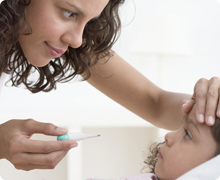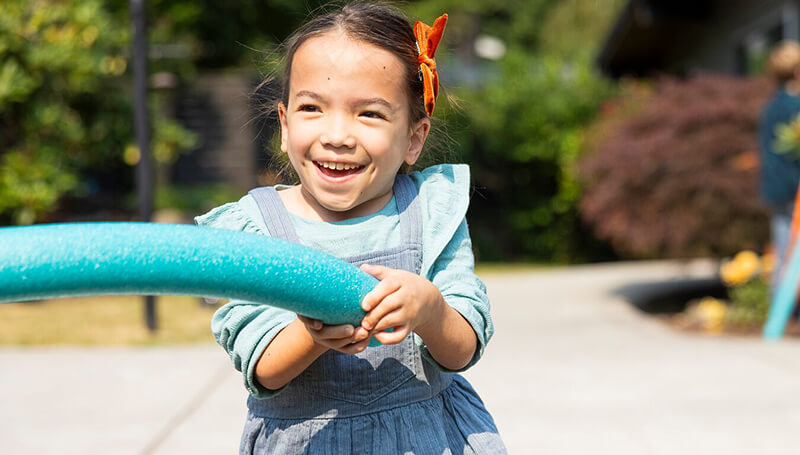Fever
 What is fever?
What is fever?
It is normal for the body’s temperature to change during the day. Exercise, warm clothing and hot weather can cause a small rise in temperature. A fever is a body temperature of over 100.4 degrees F (or 38.0 degrees C). Most of the time fever is not harmful. Fever is the body’s way of fighting an illness.
Treatment of a Fever
You do not always need to treat a fever. The best thing to do is to watch how your child acts. Are they eating and sleeping well? How do they look? Do they play at times? If they are not comfortable, you can try these tips.
Things you should do for a fever:
- Offer extra fluids to drink all through the day.
- Dress your child in comfortable clothes or pajamas. Avoid too many clothes or bundling. This can raise body temperature.
- Decide if your child is comfortable. If not, you can give acetaminophen (Tylenol) if your child is over 3 months old. You can give acetaminophen or ibuprofen (Motrin) if your child is over 6 months old. Make sure to give the correct dose based on your child’s weight. Use the measuring tool that came with the medicine. Follow the instructions on the medicine.
- Make sure your child gets enough rest. Visit Activities for Children Sick at Home for ideas for things your child can do when they're not sleeping.
Things you should not do for a fever:
- Do not use rubbing alcohol or ice water to cool your child down.
- Don’t worry if your child is not eating solid food. Liquids are needed most during a fever.
- Don’t wake your child up to give them fever medicine.
- Don’t ever give aspirin to your child.
- Don’t give fever medicine to a baby under 3 months old, unless told to by a doctor.
- Don’t use ibuprofen for babies less than 6 months unless told to by a doctor.
- Don’t switch between acetaminophen and ibuprofen unless told to do so by your doctor. Choose one and stick with the dosing schedule to avoid the risk of giving too much.
Call the doctor if your child:
- Is less than 3 months and has a fever. Call right away.
- Is 3 months to 2 years old, has had a fever for more than 24 hours and has no other symptoms.
- Has a fever for more than 3 days.
- Is in pain or complains of pain, especially in the neck, ears or throat.
- Is very cranky or sleepy.
- Has trouble breathing or is breathing fast.
- Has a seizure.
- Has a rash (except chicken pox).
- Has dry lips, tongue or mouth.
- Vomits often or for more than a day.
- Has not wet a diaper or gone pee in 8 hours.
- Has a chronic health condition that weakens their immune system.
- Has a fever of over 104 degrees F (or 40 degrees C)
- Is not alert when awake (lethargic).
When can my child return to school or day care?
Most fevers caused by a viral infection last for 2 or 3 days. Your child can return to school or day care once they have not had a fever for 24 hours (without having taken a medicine to reduce the fever during those 24 hours.) They should feel well enough to take part in normal activities.
Thermometers
There are many kinds of thermometers. Choose a thermometer and use the same method for taking your child’s temperature during the course of an illness. It’s easier to track changes.
Types of thermometers
Multi-use digital thermometers
Multi-use digital thermometers can be used in the mouth (orally), in the bottom (rectally) or in the armpit (axillary). Once you have used a thermometer in your baby’s bottom, do not use it in mouths. Label it “bottom” and use a different one for mouths.”
Multi-use digital thermometers can be used in the mouth (orally), in the bottom (rectally) or in the armpit (axillary). Once you have used a thermometer in your baby’s bottom, do not use it in mouths. Label it “bottom” and use a different one for mouths.
Ear (tympanic) thermometers
Ear (tympanic) thermometers measure the temperature in the eardrum. They give good readings for babies and children over 6 months old.
Temporal artery thermometers
Temporal artery thermometers measure heat on the side of the forehead in children 3 months and older.
Mercury, strip and pacifier thermometers
Avoid using strip or pacifier thermometers because they don’t give good results.
The American Academy of Pediatrics advises that parents stop using thermometers that contain mercury. This is because your child could be harmed by mercury if the thermometer breaks.
Taking Your Child’s Temperature With a Multi-Use Thermometer
First, clean the thermometer with warm soapy water or wipe it with rubbing alcohol. Rinse it with cool water. Always stay with your child while taking a temperature. Remember to clean the thermometer again before putting it away.
Bottom (rectal) temperature (from birth up to 3 years old)
- Dab some lubricant that does not contain petroleum (like KY Jelly) on the tip of the thermometer.
- Place your baby lying face down or on their side with the knees drawn up to the belly.
- Turn the thermometer on. Gently insert it into the opening in their bottom (rectum), about 1/2 to 1 inch. You will know when to stop inserting when the silver tip disappears.
- Keep one hand firmly on your child.
- Read the temperature when you hear the “beep.”
Mouth (oral) temperature (for once children are 4)
- Wait 15 minutes after your child eats or drinks.
- Turn the thermometer on. Gently put the tip under one side of your child’s tongue, toward the back. Have your child keep their lips closed.
- Read the temperature when you hear the “beep.”
Armpit (axillary) temperature (for children and babies, including newborns)
This is not the best way to take your child’s temperature. It’s used in schools and child care centers because it’s easy and less likely to spread germs, but the results aren’t accurate.
- Turn the thermometer on. Place the tip in the top of your child’s armpit, next to the skin.
- Hold your child’s arm tightly against their chest.
- Read the temperature when you hear the “beep.” Do not add degrees to the reading. Go by what the thermometer says when it beeps.
Taking Your Child’s Temperature With an Ear (Tympanic) Thermometer
This kind of thermometer works for children over 6 months old.
- Put a new, throw-away cover on the tip of the thermometer.
- Gently pull your child’s ear straight back and ask them not to move.
- Place the tip of the thermometer in the opening of the ear. Be careful not to push hard or too far in the opening.
- Press the button until the thermometer beeps.
- Remove the thermometer from the ear and read the temperature.
- Throw the used cover in the garbage.
Taking Your Child’s Temperature With a Forehead (Temporal Artery) Thermometer
This kind of thermometer works for children 3 months and older.
- Turn the thermometer on and place it in the center of your child’s forehead.
- Gently sweep the thermometer across your child’s forehead, stopping at their hairline.
- Lift the thermometer and quickly touch it to your child’s neck, just behind the ear lobe.
- Remove it from your child and read the temperature.


